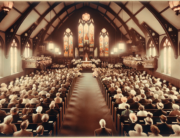History has not been overly kind to most movements. Just reflect on what has happened to the Civil Rights movement after the death of Martin Luther King. It lost most of its momentum. Movements need a strong, charismatic leader. When the leader dies, most movements wane. For these movements to have a lasting impact, it is imperative that they avoid going the way of most movements. So here are my thoughts on what might happen and what should happen.
We are witnessing the birth of two huge movements – church planting centers in churches and multi-site congregations. In this section I want to focus on the church planting centers.
Church Planting Movements
Over the past decade, a number of churches have initiated the beginnings of what could become one of the most significant movements in church history since the Reformation. I am running into multiple churches that have established church planting centers within them and have staffed their center with a full-time person in charge of raising up church planters who will develop their own church planting center. The goal of these churches is not simply planting churches; their goal is planting churches that will develop a church planting center within them and plant churches that will plant churches. Some of these churches are planting dozens of churches each year and are the grandparents of hundreds of congregations.
It has been a long time in Protestantism since we have seen the number of church plants that we are seeing today. In fact, the number of new churches recently exceeded the number of churches being closed. I read somewhere recently that over the past decade, thirteen of these planting churches account for more church plants than all other denominations combined. Whether that is fact or fiction, the fact that the story is circulating tells us that something is afoot, and perhaps more of us should pay attention.
Since movements tend to come and go, we will be wise to note how that happens so we can avoid the failure of the present church planting movement.
Phase One:
A vision for church planting is born in the heart of a leader or group of leaders. In time, a “leader of leaders” emerges to lead the movement. This leader gains authority, not by position or power, but by his or her passion and dedication to the vision. Because of the passion, innovation, persuasiveness, and ability of this individual to attract other leaders of leaders, the movement catches fire and rapidly spreads – much like an out-of-control wildfire advances unabated through a forest.
Phase Two:
In the early stages of the movement, church planters have direct contact with the founder of the movement. But Phase Two brings a new twist. Over time, the leader of leaders becomes less available to the core leaders due to the growing number of church plants and the increasing organizational demands. Therefore, the movement begins to align the church planters around the DNA of the movement more than the passion of the leader of the movement. Church planters emerge who do not know the founder. They know the stories, but they missed the passion that ignited the movement. At this point, the person in charge of the church planting center attempts to fill the void and convey the passion of the founder.
Somewhere between Phase One and Phase Two, it is not unusual for the founder to assume the mantle of Apostle, and begin to spend less and less time at the original church. Such a response is both natural and necessary in order to keep the passion of the founder at the heart of the movement.
Phase Three:
But no matter how hard the founder tries, the decentralization of his or her passion continues to grow as the movement explodes. Because of the exponential multiplication of congregations and church planting centers, the movement can no longer rely on the intense presence and passion of either the founder or even a point person from the original church planting center to model the DNA to the core group of church planters. At this point, the leaders can no longer assume that all of the church plants will live out the DNA.
The movement begins to break down and, if it is not careful, it responds by establishing a centralized board with paid staff in an attempt to ensure predictable corporate behavior among the church plants. At the very best, the board is for policy governance. At worst, it is dedicated to the management of both the DNA and the individual churches. Either way, the establishment of a board signals the beginning of the decline for the movement and the beginning of an institution. Because of this shift from mission to maintenance, church planters begin to focus more on planting churches than establishing churches that develop church planting centers within them. Just consider the United Methodist Church, which was born by the Circuit Rider and now is in a free-fall decline. It went from two charismatic leaders who had a passion and let that passion run wild from the East Coast to the West Coast. But over time the passion died, the institution was born, and death is now just around the corner.
If leaders are not careful, management replaces mission and the leaders are drawn increasingly into the management of the movement. More time is spent managing the movement than fueling the movement. What were once free wheeling “mission outposts” with a common DNA have now become disconnected “management silos.” Even more deadly, boards and institutions require standardization and shun innovation. Management silos require predictability, and the movement loses its edge. At this point, the movement responds by developing quality control systems and attempts to centralize authority. Now, instead of authority arising out of the passion of the leader, it is managed by a Board. Quest for quality now fills the void once occupied by innovation, thus encouraging standardization of methodology. Staff behaves more like professionals than artists.
Phase Four:
Centralized and removed from the field, executive management becomes paralyzed. It lacks credibility and is not sensitive to the rapidly changing mission field, and survival of the organization or institution becomes the goal. Now church planters are building churches rather than being part of a movement, and church planting slows to a trickle. Executives at the top or center feel isolated, and the movement is virtually dead.
So What’s The Solution?
The big question for church planting movement leaders is, “What are you doing to avoid moving from Phase Two to Phase Three or, better yet, to remain in Phase One? What are you going to do to ensure the continuation of the movement?” What I fear is that the third and fourth generations of church planters are most likely going to focus on building a church rather than facilitating a movement. This shift cannot be allowed to happen! Too much is at stake.
To answer this question, we turn to the first church planting movement – the missionary trips of Paul. What did he do to ensure the movement would continue?
First, he stayed in close contact with the churches he planted. This was a chore in his day. What avenues are you using to personally stay in touch with all of the leaders of leaders in your movement? In some areas of the world, it is simple through the Internet and email.
Second, he visited and revisited the church plants. There is nothing that can compare to experiencing the passion of the leader of leaders.
How will you achieve these first two points? Let me suggest that you focus on planting churches that agree to establish a church planting system as part of their DNA. Then, bring these leaders of leaders together every year to spend a week or month with the founder. Paul continually gathered a core team around him and trained them to be leaders of leaders.
Who is in your stable of leaders of leaders? Are you raising them up for that purpose? This is your primary task. Imprint the DNA of the movement in the lives of those who are leading church planting centers. Focus on them, not on the planting of churches.
The movement does not need a board; it needs a group of leaders of leaders to form an “apostolic team.” This is the team that becomes the “leaders of leaders.” Instead of the movement depending on the passion of a leader of leaders, a core group of passionate vision casters of the movement’s DNA are scattered about so that every plant is visited annually. This is the primary way to deal with the loss of the movement’s founder.
One of the things that gives me hope for the present church planting movement is that it doesn’t have one centralized leader but is being fueled by dozens of leaders whose passion for church planting is igniting fires all across the U.S. We need to be grateful for the cadre of church planting leaders that is emerging.
The other thing that gives me hope is the role Exponential is playing in this movement. It doesn’t function as a board. Instead, it functions as a broker of information. They are bringing church planters together with some of the most effective movement makers on the planet. This is the way forward.
Are you reproducing yourself? Doing so is more important to your movement than the planting of churches.
Question: How have you seen leaders ensure the continuation of the church planting movement? Share your thoughts in the Comments section below.






Add Comment